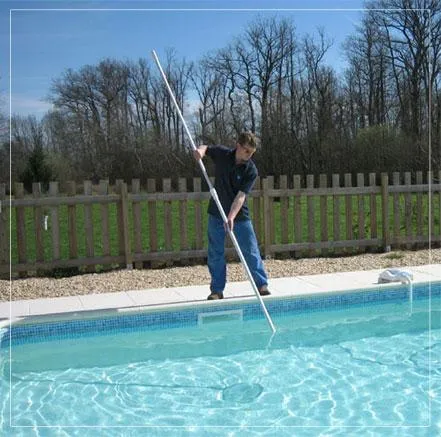POOL STAIN AND SCALE BUILDUP
Inorganic materials like copper, iron, magnesium, calcium or aluminum can cloud or discolor the pool water and stain or scale the pool surfaces, especially the plaster and tile grout. When a precipitated metallic salt such as calcium or magnesium remains in suspension, it can cause turbidity or cloudiness of the water. When heavy metal minerals are in suspension, they'll color the water. When these minerals quit floating around and decide to attach themselves or deposit on interior pool surfaces, the mineral salts such as carbonates of magnesium and calcium form a whitish crystallized deposit known as scale. If the precipitated minerals have color, as heavy metals often do, they will deposit themselves in the form of a stain.
Minerals like iron, calcium and copper exist naturally in trace amounts in your pool water. They may originate from the source water, that is, the water used to fill the pool. Well water is notoriously high in mineral content. Not much we can do about minerals entering in this manner. Other means of entry are more controllable.
Iron and copper pipes, fittings and equipment found in older pools are subject to corrosion by harsh chemical conditions, such as high chlorine. They also erode slowly with the everyday force of water rushing through. This corrosion and erosion releases heavy metal ions into the pool, which may be forced out of solution (precipitated), creating dramatic color schemes when free floating and stains when they deposit themselves.
Another source of metal ions occurs when two dissimilar metals are placed in close proximity to each other. For example, iron pipe connected to copper pipe, or a brass valve connected to aluminum equipment. These metals will attempt to exchange ions; water rushing in between them prevents the exchange, carrying off bits of their essence to the pool.
A frequent source of copper discoloration and staining is the heat exchanger in the heater. Water rushing through the 8 or 10 tube, copper finned heat exchanger, at possibly higher than normal flow because of an oversized pump or faulty bypass valve, or containing corrosive water with high chlorine levels and/or low pH, will strip the copper right out. Corrosion and scaling conditions are dramatically increased by the high temperature found in heaters. As heat exchangers erode, the pool becomes stained and the exchanger tube walls become thin and begin to leak.
Finally, staining can occur with the improper use of ionization systems and metal based algaecides. Copper is a known algaestat, while silver ions are a good bactericide. Copper and silver ionizers inject these metals into the water for contaminant control, however, if the water balance is out of control, or mineral levels are too high, staining can occur.
Preventing Mineral Problems
Balanced pool water is such that it has neither a tendency towards corrosion or scaling. At the most basic level, pool water must be balanced to control stains and scale. pH or alkalinity that is allowed to drift and/or high calcium hardness levels can promote mineral precipitation. This can be easily accomplished with a weekly cleaning and maintenance
from HQ Pools.
The use of a sequestering agent is recommended for pools which have metal plumbing, fittings, heaters, ionizers or use metal algaecides or fill their pool with well water. These agents keep minerals tied up in solution like molecular glue.
CORRECTING MINERAL PROBLEMS
For pools that are discolored or cloudy due to precipitated minerals, the path back to blue may be accomplished by shock treatment with sodium or lithium hypochlorite, accompanied by constant filtration and use of a clarifier. Use of a flocculent to drop suspended particles to the floor for vacuuming. Partial drainage and dilution of the pool water, especially in cases where the pool is at or near saturation. When TDS levels are too high, the water can accommodate no more dissolved material and must throw off some of it in the form of precipitation.



